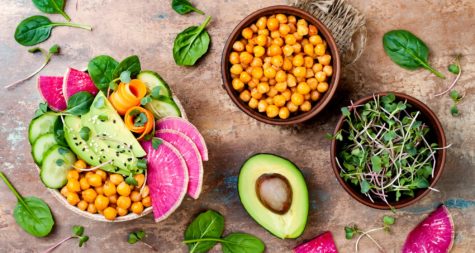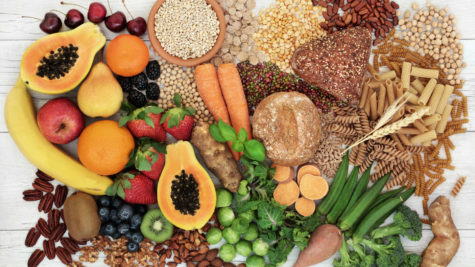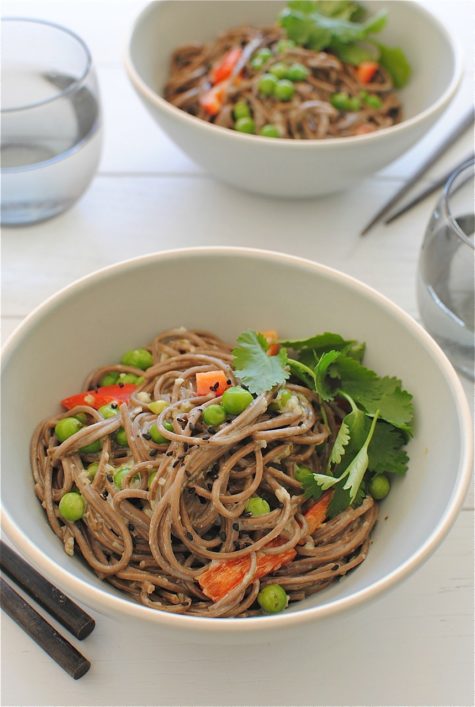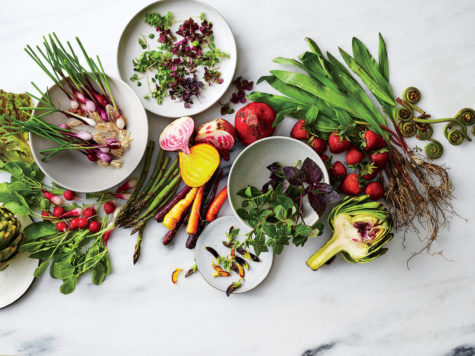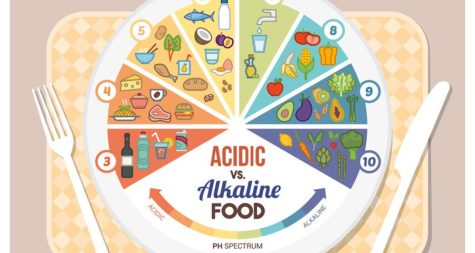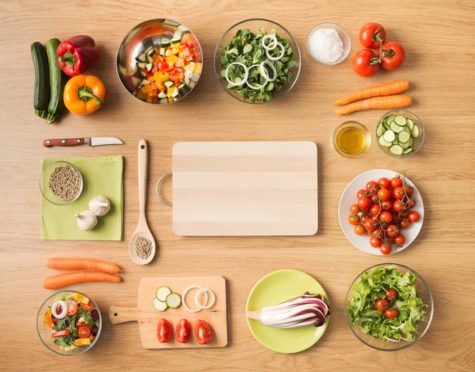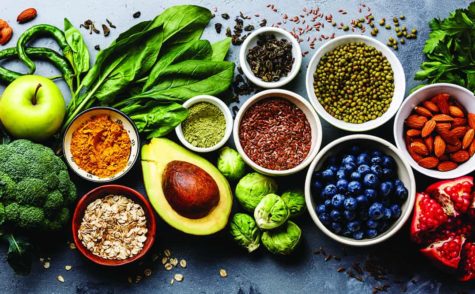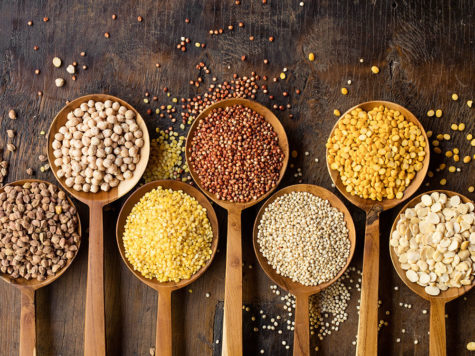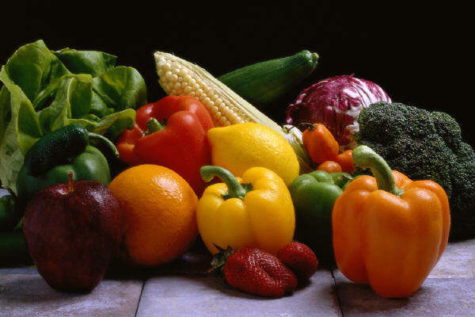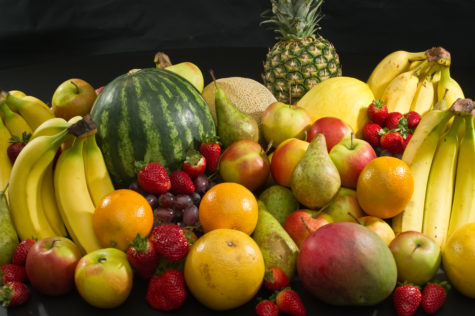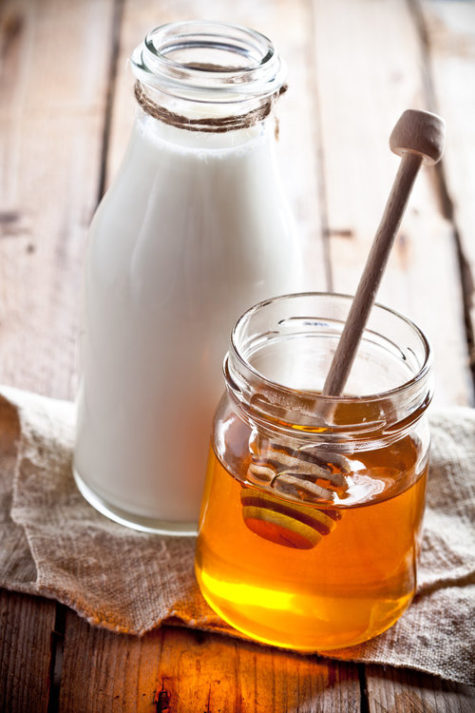Monthly Archives: November 2018
Importance of Dietary Fiber
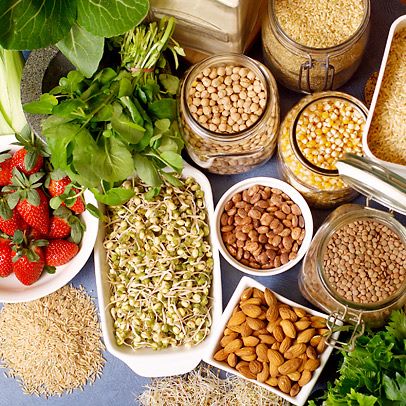
Fiber forms the skeletal system of plants. Without it no plant or tree would be able to stand upright. Dietary fiber, the roughage of yesteryear, consists of those parts of the plant foods that cannot be digested by enzymes or other digestive secretions in the alimentary canal.
Dietary fiber plays an important role in the maintenance of health and prevention of diseases. There is sufficient evidence to suggest that an artificial depletion of fiber as in case of refined cereals and sugar has over the last 100 years contributed to several degenerative diseases. Recent studies in this area indicate that sufficient intake of fiber-rich diet may help prevent obesity, colon cancer, heart disease, gallstones, irritable bowel syndrome, diverticulosis and diabetic conditions.
Studies have also established that dietary fiber is a collection of elements with a variety of functions rather than a single substance with single function as was assumed earlier. This new insight into the true nature of fiber has given the lie to old beliefs that bran is synonymous with fiber, that all fiber is fibrous or stringy and that all fiber tastes the same.
Physiological effects
Fiber in the diet promotes more frequent bowel movements and softer stools having increased weight. The softness of stools is largely due to the presence of emulsified gas which is produced by the bacterial action on the fiber. A high fiber intake results in greater efficiency in the peristaltic movement of the colon. This helps in relieving the constipation which is the main cause of several acute and chronic diseases.
Recent studies suggest that increasing the dietary fiber intake may be beneficial for patients with irritated bowel syndrome who have diarrhea and rapid colonic transit, as well as to those who have constipation and slow transit. The high fiber diet, like bran, thus regulates the condition inside the colon so as to avoid both extremes – constipation and diarrhea.
Investigations have shown that several potential carcinogens are produced in the feces. Their production is related to the acidity of the gut content. The greater the acidity in the bowel content, the less is the production of these carcinogens. The breaking down of the fiber by bacteria renders the feces more acidic. This reduces the amount of possible carcinogenic substances.
Fiber also reduces the possibility of formation of harmful toxins in the large intestine by reducing the intestinal transit time of the food contents. Dietary fiber increases the bacteria in the large intestines which require nitrogen for their growth. This in turn reduces the chances of cancerous changes in cells by reducing the amount of ammonia in the large bowel.
Fiber reduces the absorption of cholesterol in the diet. It also slows down the rate of absorption of sugars from the food in the digestive system. Certain types of fiber increase the viscosity of the food content. This increased viscosity indirectly reduces the need for insulin secreted by the pancreas. Thus a fiber-rich diet can help in diabetes mellitus.
Sources of Fiber
The most significant food sources of fiber are unprocessed wheat bran, whole cereals such as wheat, rice, barley, rye, millet; legumes such as potato, carrots, beet , turnip and sweet potato; fruits like mango and guava and leafy vegetables such as cabbage, lettuce and celery.
The percentage of fiber content per 100 grams of some foods are:
- Bran 10.5% to 13.5%
- Whole grain cereals 1.0% to 2.0 %
- Nuts 2.0% to 5.0%
- Legumes 1.5% to 1.7%
- Vegetables 0.5% to 1.5%
- Fresh fruits 0.5% to 1.5%
- Dried fruits 1.0% to 3.0%
The foods which are completely devoid of fiber are meat, fish, eggs, milk, cheese, fats and sugars. Bran, the outer coverings of grains, is one of the richest sources of dietary fiber. And it contains several types of fiber including cellulose, hermicellulose and pectin. Wheat and corn bran are highly beneficial in relieving constipation.
Experiments show that oat bran can reduce cholesterol levels substantially. Corn bran is considered more versatile. It relieves constipation and also lowers LDL cholesterol, which is one of the more harmful kinds.
Besides being rich in fiber, bran has a real food value being rich in time, iron and vitamins and containing a considerable amount of protein. Dr.Dennis P. Burkitt, a noted British physician remarks, ” Grain roughage, such as rich bran and wheat bran, are an essential part of a healthy diet, and a preventive against diseases like piles, constipation, bowel cancer, varicose veins and even coronary thrombosis. ” Dr. Burkitt worked for many years in Africa and found after a series of observations that rural Africans who eat bulk of fibrous foods rarely suffer from any of these diseases.
Legumes have high fiber content. Much of this fiber is water- soluble, which makes legumes likely agents for lowering cholesterol. Soy beans, besides this, can also help control glucose levels. The types of fiber contained in vegetables and fruits contribute greatly towards good health. The vegetables with the biggest fiber ratings include sweet corn, carrots, potatoes, parsnips and peas. And among the high ranking fruits are raspberries, pears, strawberries and guavas.
Types of Fiber
There are six classes of fiber. They are cellulose, hemicellouse, pectin, gums, mucilage and lignin. They differ in physical properties and chemical interactions in the gut, though all except lignin are poly-saccharides. The facts known so far about these forms of fiber as a result of various studies are discussed below.
- Cellulose :
It is the most prevalent fiber. It is fibrous and softens the stool. It abounds in fruits, vegetables, bran, whole-meal bread and beans. It is also present in nuts and seeds. It increases the bulk of intestinal waste and eases it quickly through the colon. Investigations indicate that these actions may dilute and flush cancer-causing toxins out of the intestinal tract. They also suggest that cellulose may help level out glucose in the blood and curb weight gain.
- Hermicellulose :
It is usually present wherever cellulose is and shares some of its traits. Like cellulose, it helps relieve constipation, waters down carcinogens in the bowel and aids in weight reduction. Both cellulose and hemicellulose undergo some bacterial breakdown in the large intestine and this produces gas.
- Pectin :
This form of fiber is highly beneficial in reducing serum cholesterol levels. It, however, does not have influence on the stool and does nothing to prevent constipation. Research is being conducted to ascertain if pectin can help eliminate bile acids through the intestinal tract thereby preventing gallstones and colon cancer. It is found in apples, grapes, berries, citrus fruits, guava, raw papaya and bran.
- Gums and Mucilage :
They are the sticky fibers found in dried beans, oat bran and oatmeal. Investigations have shown that they are useful in the dietary control of diabetes and cholesterol.
- Lignin :
The main function of lignin is to escort bile acid and cholesterol out of the intestines. There is some evidence that it may prevent the formation of gallstones. It is contained in cereals, bran, whole meal flour, raspberries, strawberries, cabbage, spinach, parsley and tomatoes.
Best Practices
The best way to increase fiber content in the diet is to increase the constipation of wholemeal bread, brown rice, peas beans, lentils, root vegetables and sugar -containing fruits, such as dates, apples, pears and bananas. The intake of sugar, refined cereals, meat, eggs and dairy products should be reduced. Candies, pastries, cakes which are rich in both sugar and fat, should be taken sparingly. White processed bread should be completely eliminated from the diet.
Daily Requirements
There are divergent views as to the requirement of dietary fiber for good health. There is no recommended daily dietary allowance for it and hardly any data about optimum amounts. Some Africans known for lower incidence of degenerative diseases take about 150 grams of fiber a day. In Europe and North America, where there is a high incidence of such diseases, people take 25 grams or less a day.
Dr. John H. Cummings, a noted fiber expert in England, considers that a fiber intake of 30 grams (about one ounce) per day is sufficient for good health. Excessive consumption of fiber, especially bran, should however, be avoided.
Due to its content of crude fiber, bran is relatively harsh and it may irritate the delicate functioning of the digestive system, especially in the sick and the weak. Excessive use of fiber may also result in loss of valuable minerals like calcium, phosphorus, magnesium and potassium from the body through excretion due to quick passage of food from the intestine.
Health Promotion the Vegetarian Way
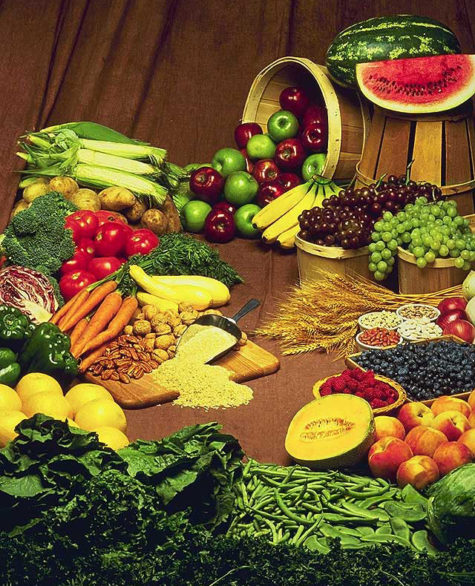
The word ” Vegetarian ” was coined by the Vegetarian Society of the United Kingdom in about 1847. The word does not come from vegetable as is generally assumed : It is a derivation of the Latin word ‘ vegetari ‘ which means to enliven.
The practice of vegetarianism, however, goes far back in history. Many noted philosophers and religious teachers urged their followers to avoid a flesh diet. Brahminism, Jainism, Zoraostrianism and Buddhism acknowledged the sacredness of life and the need to live without causing suffering; so did many of the early Christians.
There are various types of vegetarians. ” Vegans “are the strictest vegetarians who eat only plant foods and exclude all animal by-products such as eggs, milk, cheese, curd, butter, ghee and even honey. There are ” lacto vegetarians ” who eat plant foods as well as dairy products and ” lacto-avo vegetarians ” who eat eggs besides plant foods and dairy products. There are even fish-eating vegetarians. The common factor among them is that they do not eat the flesh of warm- blooded animals.
Meat seems to have assumed an exaggerated importance nutritionally. It is generally mistakenly believed that nutritional deficiencies , especially of proteins and vitamin B12 and poor health may result if animal foods are eliminated. Studies however, have indicated to health problems or deficiency diseases for those on a vegetarian diet.
Of the 22 amino acids -the essential components of proteins – needed by the body for its normal functioning, only nine need be supplied by the diet as the body synthesizes the remaining 13. The body can use 100 per cent of this protein if all ten amino acids are in ideal proportions. If, however, one or more of the essential amino acids are present in less than the ideal amount, the value of the entire protein is reduced in the same proportions. On a quality rating scale of 1 to 100, egg protein is 95, milk is 82, meat and poultry are 67, fish 80, grains are between 50 to 70 and legumes, nuts and seeds are between 40 and 60.
The so-called protein deficiency in a vegetarian diet is in fact more imaginary than real as the contribution of the protein value of the green vegetables has been ignored and the true protein requirement is less than that assumed. Green vegetable protein is as high in quality as milk protein and thus makes a very valuable contribution to the vegetarian’s protein nutrition. The high quality of protein balances the lower quality of other vegetarian proteins such as nuts and beans.
The recommended daily allowance of 70 value proteins is 44 grams per day for women and 56 for men. Researchers have now discovered that the actual protein requirement is much less, being 15 grams per day of 100 value protein or 21.5 grams of 70 value protein or 30 grams of 50 value protein. A wholesome vegetarian diet can, therefore, easily meet the body’s protein needs.
Moreover, it is possible to combine two low-value plant proteins to get a protein of higher quality. Thus, wheat which has a deficiency in the amino-acid lysine but an abundance of sulphur containing amino-acids can be combined with beans which have the opposite enrichment combination. Taken together, they complement each other to form a complete protein.
As regards the adequacy of B12 nutrition, laco-avo vegetarians and lacto-vegetarians should not feel concerned on this score, as the B12 needs can be easily supplied by dairy products and eggs. A quarter liter of milk or 100 grams of cheese or 1 egg per day will supply the recommended daily allowance. This vitamin once eaten is stored in the liver. Vegans, however, do not get this vitamin in their food, yet reliable scientific studies have found no evidence of B12 deficiency diseases. It is therefore, presumed that this vitamin can be synthesized in the body.
Auto-Intoxication
Most diseases of the human body are caused by auto-intoxication or self-poisoning. The flesh of animals increases the burden of the organs of elimination and overloads the system with animal waste matter and poisons. Chemical analysis has proved that uric acid and other uremic poisons contained in the animal body are almost identical to caffeine, there and nicotine, the poisonous stimulating principles of coffee, tea and tobacco. This explains why meat stimulates the animal passions and creates a craving for liquor, tobacco and other stronger stimulants.
Excessive uric acid resulting from meat-eating also causes diseases such as rheumatism, Bright’s disease, kidney stones, gout and gall stones. Meat proteins cause putrefaction twice as rapidly as do vegetable proteins. The morbid matter of the dead animal body is foreign and uncongenial to the excretory organs of man. It is much harder for them to eliminate the waste matter of an animal carcass than that of the human body. Moreover, the formation of ptomains or corpse poisons begins immediately after the death of the animal and meat and poultry are usually kept in cold storage for many days and even months before they reach the kitchen.
Another powerful influence tends to poison the flesh of slaughtered animals. As is well known, emotions of worry, fear and anger actually poison blood and tissues. Imagine the excitable condition of animals after many days of travel, closely packed in shaking vehicles – hungry, thirsty, scared en route to the slaughter -houses. Many die even before the end of their journey. Others are driven half dead with fear and exhaustion to the slaughter pans, their instinctive fear of death augmented by the sight and odor of the blood shambles.
Flesh is often a carrier of disease germs. Diseases of many kinds are on the increase in the animals, making flesh foods more and more unsafe. People are continually eating flesh that may contain tuberculosis and cancerous germs. Often animals are taken to the market and sold for food when they are so diseased that their owners do not wish to keep them any longer. And some of the processes of fattening them to increase their weight and consequently their market value, produce disease. Shut away from light and pure air, breathing the atmosphere of filthy stables, perhaps fattening on decaying foods, the entire body now becomes contaminated with foul matter.
Benefits of Vegetarianism
A vegetarian diet can have many nutritional benefits, if it is rich in fruits and vegetables, and contains moderate amounts of seeds, nuts, whole grains and legumes. One of the main benefits of a proper vegetarian diet is its low caloric content in relation to the bulk supplied, which helps maintain ideal weight.
Another benefit of the vegetarian diet is the much lower intake of fat, if dairy products, seeds and nuts are eaten sparingly. This accounts for lower serium cholesterol levels found in vegetarians, which considerably reduces the risk of developing heart diseases and breast and colon cancer.
A third nutritional advantage of the vegetarian diet is its high fiber content. Fiber, being indigestible, increases the bulk of the faces, keeps them soft and makes them easy to expel. One study has indicated that lacto-avo vegetarians consume twice as much and vegans four times as much fiber as non-vegetarians. High fiber intake has been associated with decreased risks of diseases of the colon, appendicitis, cancer of the colon and rectum, hiatus hernia, piles and varicose veins.
McCarrison, one of the greatest authorities on food, has outlined a perfect diet. According to him:
” a perfectly constituted diet is one in which the principal ingredients are milk, milk products, any whole cereal grain or mixture of cereal grains, green leafy vegetables and fruits. These are the protective foods. They make good the defects of other constituents of the diet, protect the body against infection and disease of various kinds, and their use in sufficient quantity ensures physical efficiency. ”
Vegetarianism is thus a system based on scientific principles and has proved adequate for the best nutrition free from the poisons and bacteria of diseased animals. It is the best diet for man’s optimum, physical, mental and spiritual development.
Secrets of Food Combining
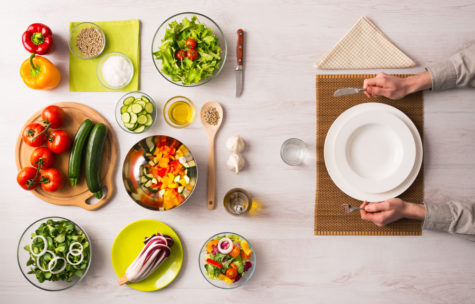
The observance of rules of food combining is neither faddish nor eccentric. It is a simple, scientifically -based system of selecting foods, from among different types, which are compatible. This facilitates easy and efficient digestion and ensures after-meal comfort. Digestion is not merely chemical or physical process, but also a physiological one.
When food enters the body, it undergoes several changes before it is broken down into its constituent parts and assimilated. But no food can be assimilated by the system and used by various organs unless it has first been digested and then absorbed in the digestive system known as alimentary canal, while the residue, unfit for absorption is eliminated from the system.
The chemical part of digestion is accomplished by a series of juices and their enzymes. The juices alternate between alkalies and acids, and their character is determined by the requirement of the enzymes they contain. These enzymes remain active in suitable media of well defined acid-alkaline ranges and are destroyed in unsuitable media.
For instance, the salivary amylase (ptyalin) or starch-splitting enzyme of the mouth is active only in an alkaline media and is destroyed by a mild acid. The gastric enzyme, pepsin, which initiates protein digestion, is active only in the acid medium and is destroyed by alkalies.
A noteworthy feature of the digestive secretions is that the body suits its fluid and enzymes to the character of the food eaten. There are, however, severe limitations in this process. It is possible to suit the juices to a particular food, however, complex it may be, but not to a variety of foods taken together. It is the combining of many varieties and incompatible foods at a meal that causes 90 per cent of digestive disorders.
There is a marked tendency to gastro-intestinal fermentation with certain combinations of foods. There is no fermentation and digestion will be much more satisfactory when the foods comprising a meal are of the same type. This generally means eating similar foods at one time in order to accomplish the most complete digestion.
The most important rule for combining foods is to avoid mixing protein and carbohydrate concentrated foods. Although every food contains some protein, those regarded as protein concentrated foods demand the longest digestive time. They are held in the stomach for some hours until the gastric juices has performed its task. This may vary from two-and-a-half to six hours, depending upon the complexity of the protein in the food.
If a protein food is mixed with starch-concentrated or sugar-concentrated foods, it will usually result in fermentation. This may lead to indigestion and gas in the stomach. Animal-food proteins, such as meats, fish and cheese, require very high concentration of hydrochloric acid. Their gastric digestion will be greatly inhibited by carbohydrate fermentation in the stomach. This will produce more gas and increased discomfort. Eating meat, potatoes, bread and sweets should, therefore, be especially avoided.
Protein foods are best digested when eaten with fresh vegetable salad. Primary protein foods such as nuts, seeds and soy beans also combine very well with acid fruits like oranges, pineapples, grapefruit and lemons, and fairly well with sub-acid fruits, like grapes, pears, apples, berries, apricots and peaches. These vegetables and fruits are rich natural sources of vitamin C which aids protein digestion.
The second important rule for food combining is to avoid mixing proteins and fats at the same meal. Fat in foods inhibits the secretion of gastric juice through the small wall. Thus when fat-concentrated foods are taken with protein foods, gastric catabolism will decrease by the degree of liquid concentration in the stomach. Fat will remain undigested in the stomach until gastric juices complete their work on the complex protein molecule.
Although all primary protein foods contain high concentration of fat, such lipids will be held in suspension, awaiting catabolism in the intestine, without impeding gastric action. Free fats like oil, butter, and milk tend to coat the gastric mucoa, thereby inhibiting its effort to secrete gastric juice. Fat surrounding fried foods is also regarded as free fat and it interferes with gastric catabolism.
Another important rule for food combining is to avoid mixing carbohydrates and acid fruits in the same meal. The starch-splitting enzyme ptyalin in the saliva plays an important role as the food is chewed. It converts the complex starch molecules into simpler sugars. Ptyalin requires a neutral or slightly alkaline medium for proper functioning and this is the normal condition of the saliva in the mouth. However, when acid foods are taken, the action of ptyalin is halted.
It is, therefore, necessary to avoid acid fruits in the same meal as sweet fruits or starches. Thus tomatoes should not be eaten with starches especially potatoes or bread. Refined sugar products are also acidic, both in the mouth and in the bloodstream. The acidifying of the saliva by sucrose is one of the main causes of tooth decay. It can also cause severe damage to the digestion. Food combining is designed to facilitate easier digestion.
In a nutshell:
- Starches, fats, green vegetables and sugars may be eaten together as they require either an alkaline or neutral medium for their digestion
- Proteins, green vegetables and acid fruits may be eaten together as they require an acid or neutral medium for their digestion
- Starches and proteins; fats and proteins; and starches and acid fruits should not be eaten together as a general rule
This in brief is the whole basis for successful food combination. An important point to remember about meals is that the smaller the number of courses they consist of, the better it will be. They should approximate to a one-course meal as much as possible. Simple meals in every way are more conducive to health, than more elaborate ones, no matter how well they may be combined.
A meal consisting of proteins, carbohydrates and fats may remain in the stomach for six to seven hours before the stomach is emptied. If carbohydrates are eaten without proteins, they remain in the stomach for a relatively short period. A fruit meal remains in the stomach for even shorter time. It is advisable to eat these different foods at different meals – a fruit meal, a starch meal and a protein meal.
The ideal practice is a fruit meal for breakfast, a starch meal with salad and non- starchy vegetables for lunch, and a protein meal with a salad and non-starchy vegetables for dinner.
Cranberry Soup
- 1 cup cranberries
- 2 cups water
- Honey to taste
- 1 tbsp potato starch
Heat cranberries and water together until cranberry skins open. Strain and add honey to taste. Bring mixture close to a boil, then remove from heat. In a separate bowl, mix starch with 2 tbsp cold water. Slowly add this mixture to the cranberry juice – stir vigorously.
Return mixture to heat and bring to full boil, stirring until it thickens and becomes slightly transparent. Store in refrigerator in a covered container. Serve w/ warm cream. Soothes colds, and is a good source of vitamins C and B.
Source: Witches of the Craft
Miracles of an Alkalizing Diet
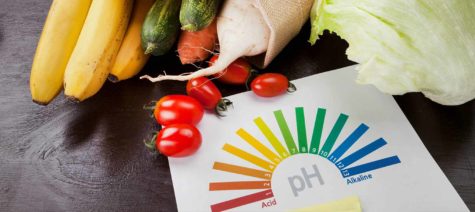
The human body is composed of various organs and parts, which are made up of tissues and cells. These tissues and cells are composed of 16 chemical elements. The balance or equilibrium of these chemical elements in the body is an essential factor in the maintenance of health and healing of disease. The acid-alkaline balance plays a vital role in this balanced body chemistry.
All foods, after digestion and absorption leave either an acid or alkaline ash in the body depending on their mineral composition. The normal body chemistry is approximately 20 per cent acid and 80 per cent alkaline. This is the acid-alkaline balance. In normal health, the reaction of the blood is alkaline and that is essential for our physical and mental well-being.
The preponderance of alkali in the blood is due to the fact that the products of the vital combustion taking place in the body are mostly acid in character. Carbohydrates and fats form about nine-tenths of the normal fuel of the body.
In normal health, this great mass of material is converted into carbon dioxide gas and water. Half of the remaining one-tenth fuel is also converted into the same gas and water. This huge amount of acid is transported by the blood to the various points of discharge, mainly the lungs. By virtue of alkalinity, the blood is able to transport the acid from the tissues to the discharge points.
Acidosis
Whenever the alkalinity of the blood is reduced, even slightly, its ability to transport the carbon dioxide gets reduced. This results in the accumulation of acid in the tissues. This condition is known as acidosis or hypo-alkalinity of the blood. Its symptoms are hunger, indigestion, burning sensation and pain in the pharynx, nausea, vomiting, headache, various nervous disorders and drowsiness.
Acidosis is the breeding ground for most diseases. Nephritis or Bright’s disease, rheumatism, premature old age, arteriosclerosis, high blood pressure, skin disorders and various degenerative diseases are traceable to this condition. It seriously interferes with the functions of the glands and organs of the body. It also lowers the vitality of the system, thereby increasing the danger of infectious diseases.
The main cause of acidosis or hypo-alkalinity of the blood is faulty diet, in which too many acid forming foods have been consumed. In the normal process of metabolism or converting the food into energy by the body, various acids are formed in the system and in addition, other acids are introduced in food. Whenever there is substantial increase in the formation of acids in the system and these acids are not properly eliminated through the lungs, the kidneys and the bowels , the alkalinity of the blood is reduced, resulting in acidosis.
Other causes of acidosis are depletion of alkali reserve due to diarrhea, dysentery, cholera etc., accumulation of carbon dioxide in asphyxia and anoxia as in circulatory and pulmonary diseases and accumulation of acetone bodies resulting from starvation, vomiting and diabetes mellitus.
Acidosis can be prevented by maintaining a proper ratio between acid and alkaline foods in the diet. Certain foods leave alkaline ash and help in maintaining the alkalinity of the food, while others leave highly acid ash and lower the alkali reserve of the blood and tissue fluids to a very large extent. Eggs do the same but less strongly than meats. Cereals of all kinds, including all sorts of breads are also acid-forming foods , though much less than meats.
All fruits, with exceptions like plums and prunes and all green and root vegetables are highly alkaline foods and help to alkalinize the blood and other tissue fluids. Thus, our daily diet should consist of four-fifth of alkaline-forming foods such as juicy fruits, tubers, legumes, ripe fruits, leafy and root vegetables and one fifth of acid-forming foods containing concentrated proteins and starches such as meat, fish, bread and cereals.
Eating sensibly in this manner will ensure the necessary alkalinity of the food which will keep the body in perfect health. Whenever a person has acidosis, the higher the ratio of alkaline forming foods in his diet, the quicker will be the recovery. Acids are neutralized by alkali. It is, therefore, imperative that persons suffering from various ailments are given adequate alkaline ash foods to offset the effects of acid-forming foods and leave a safe margin of alkalinity.
The most agreeable and convenient means of alkalizing the blood are citrus fruits and fruit juices. The alkalizing value of citrus fruits are due to large percentage of alkaline salts, mainly potash, which they contain. Each pint of orange juice contains 12 grains of potassium, one of the most potent of alkalis. Lemon juice contains nine grains of the alkali to the pint and grape seven grains.
Diet in Disease
In the diet during disease, breakfast may consist of fresh fruits, lunch may comprise raw vegetables with acid and sub-acid fruits, and for dinner raw and cooked vegetables, or light starchy vegetables like beet, carrot, cauliflower, egg-plant and squashes may be taken. Sweet fruits may be added to this diet after seven days.
Foods are classified as acid-producing or alkaline-producing depending on their reaction on the urine. Calcium, magnesium, sodium and potassium present in foods contribute to the alkaline effect, while sulfur, phosphorous and chlorine contribute to the acidic effect.
Depending on the predominating constituents in a particular food, it is classified as acid-forming or alkaline-forming. The effect of food stuffs upon the alkalinity of the blood depends upon their residue which they leave behind after undergoing oxidation in the body.
It is an error to presume that because a food tastes acid, it has an acidic reaction in the blood. For instance, fruits and vegetables have organic acids in combination with soda and potash in the form of acid salts. When the acids are burnt or utilized in the body, the alkaline soda or potash is left behind. Hence the effect of the natural fruit acids is to increase the alkalinity of the blood rather than reduce it.
Based on the above observations, the following charts show the common foods with acid and alkaline ash :
Foods Leaving An Acid Ash
The following foods are best if limited to one fifth of your total diet.
- Bananas (unripe)
- Barley
- Beans
- Bread
- Cakes
- Cereals
- Chicken
- Chocolate
- Coffee
- Confections
- Corn
- Eggs
- Grain Foods
- Lentils
- Meats
- Nuts except almonds
- Oatmeal
- Peas
- Rice
- Sea Foods
- Sugar
- Tea
Foods Leaving An Alkaline Ash
The following foods should take up about four-fifths of your total diet.
- Apricots
- Almonds
- Apples
- Banana (ripe)
- Beets
- Cabbage
- Carrots
- Cauliflower
- Celery
- Coconuts
- Cottage Cheese
- Cucumbers
- Dates
- Figs ( Fresh and Dry)
- Grapes
- Lemons
- Lettuce
- Melons
- Milk
- Onions
- Oranges
- Parsley
- Peaches
- Pears
- Pineapple
- Potatoes
- Pumpkins
- Radishes
- Raisins
- Soy beans
- Spinach
- Tomatoes
- Turnips
Optimum Nutrition for Vigour and Vitality
Your food shall be your medicine.
– Hippocrates
Diet plays a vital role in the maintenance of good health and in the prevention and cure of disease. In the words of Sir Robert McCarrison, one of the best known nutritionists, ‘The right kind of food is the most important single factor in the promotion of health ; and the wrong kind of food is the most important single factor in the promotion of disease. ”
The human body builds up and maintains healthy cells, tissues, glands and organs only with the help of various nutrients. The body cannot perform any of its functions, be they metabolic, hormonal, mental, physical or chemical, without specific nutrients. The food which provides these nutrients is thus one of the most essential factors in building and maintaining health. Nutrition, which depends on food, is also of utmost importance in the cure of disease.
The primary cause of disease is a weakened organism or lowered resistance in the body, arising from the adoption of a faulty nutritional pattern. There is an elaborate healing mechanism within the body but it can perform its function only if it is abundantly supplied with all the essential nutritional factors.
It is believed that at least 45 chemical components and elements are needed by human cells. Each of these 45 substances, called essential nutrients, must be present in adequate diets. The list of these nutrients, include oxygen and water. The other 43 essential nutrients are classified into five main groups, namely carbohydrates, fats, proteins, minerals and vitamins. All 45 of these nutrients are vitally important and they work together. Therefore, the absence of any of them will result in disease and eventually in death.
Research has shown that almost all varieties of disease can be produced by an under-supply of various nutrients. These nutritional deficiencies occur on account of various factors, including the intense processing and refining of foods, the time lag between the harvesting and consumption of vegetables and fruits, the chemicals used in bleaching, flavoring, coloring and preserving foods and the chemical fertilizers, fungicides insecticides and sprays used for treating the soil.
Therefore, as a first principle of nutrition, one should insist upon whole meal flour and whole meal bread and avoid the white stuff. Research has also shown that diseases produced by combinations of deficiencies can be corrected when all the nutrients are supplied, provided irreparable damage has not been done. A well-balanced and correct diet is thus of utmost importance for the maintenance of good health and the healing of diseases. Such a diet, obviously should be made up of foods, which in combination would supply all the essential nutrients.
It has been found that a diet which contains liberal quantities of seeds, nuts, and grains, vegetables and fruits, would provide adequate amounts of all the essential nutrients. These foods have, therefore, been aptly called basic food groups and the diet contains these food groups as optimum diet for vigor and vitality. It is described, in brief, below:
Seeds, nuts and grains :
These are the most important and the most potent of all foods and contain all the important nutrients needed for human growth. They contain the germ, the reproductive power which is of vital importance for the lives of human beings and their health.
- Millet, wheat, oats, barley, brown rice, beans and peas are all highly valuable in building health.
- Wheat, mung beans, alfalfa seeds and soy beans make excellent sprouts.
- Sunflower seeds, pumpkin seeds, almonds, peanuts and soy beans contain complete proteins of high biological value.
Seeds, nuts and grains are also excellent natural sources of essential unsaturated fatty acids necessary for health. They are also good sources of lecithin and most of the B vitamins. They are the best natural sources of vitamin C, which is perhaps the most important vitamin for the preservation of health and prevention of premature ageing. Besides, they are rich sources of minerals and supply necessary bulk in the diet.
They also contain auxones, the natural substance that play an important role in the rejuvenation of cells and prevention of premature ageing.
Vegetables :
They are extremely rich source of minerals, enzymes and vitamins. Faulty cooking and prolonged careless storage, however, destroy these valuable nutrients. Most of the vegetables are, therefore, best consumed in their natural raw state in the form of salads.
There are different kinds of vegetables. They may be edible roots, stems, leaves, fruits and seeds. Each group contributes to the diet in its own way. Fleshy roots have energy value and good sources of vitamin B. Seeds are relatively high in carbohydrates and proteins and yellow ones are rich in vitamin A. Leaves, stems and fruits are excellent sources of minerals, vitamins, water and roughage.
To prevent loss of nutrients in vegetables, it would be advisable to steam or boil vegetables in their juices on a slow fire and the water or cooking liquid should not be drained off. No vegetable should be peeled unless it is so old that the peel is tough and unpalatable. In most root vegetables, the largest amount of mineral is directly under the skin and these are lost if vegetables are peeled. Soaking of vegetables should also be avoided if taste and nutritive value are to be preserved.
Fruits :
Like vegetables, fruits are an excellent source of minerals, vitamins and enzymes. They are easily digested and exercise a cleansing effect on the blood and digestive tract. They contain high alkaline properties, a high percentage of water and a low percentage of proteins and fats. Their organic acid and high sugar content have immediate refreshing effects. Apart from seasonable fresh fruits, dry fruits, such as raisins, prunes and figs are also beneficial.
Fruits are at their best when eaten in the raw and ripe states. In cooking, they lose portions of the nutrient salts and carbohydrates. They are most beneficial when taken as a separate meal by themselves, preferably for breakfast in the morning. If it becomes necessary to take fruits with regular food, they should form a larger proportion of the meals.
Fruits, however, make better combination with milk than with meals. It is also desirable to take one kind of fruit at a time. For the maintenance of good health, at least one pound of uncooked fruits should form part of the daily diet. In case of sickness, it will be advisable to take fruits in the form of juices.
Milk, oil and honey:
The three basic health-building foods mentioned above should be supplemented with certain special foods such as milk, vegetable oils and honey. Milk is an excellent food. It is considered as ” Nature’s most nearly perfect food.” The best way to take milk is in its soured form – that is, yogurt and cottage cheese. Soured milk is superior to sweet milk as it is in a predigested form and more easily assimilated. Milk helps maintain a healthy intestinal flora and prevents intestinal putrefaction and constipation.
High quality unrefined oils should be added to the diet. They are rich in unsaturated fatty acids, vitamin C and F and lecithin. The average daily amount should not exceed two tablespoons.
Honey too is an ideal food. It helps increase calcium retention in the system, prevents nutritional anemia besides being beneficial in kidney and liver disorders, colds, poor circulation and complexion problems. It is one of the nature’s finest energy-giving food.
Daily Menu
A diet of the three basic food groups, supplemented with the special foods, mentioned above, will ensure a complete and adequate supply of all the vital nutrients needed for health, vitality and prevention of diseases. It is not necessary to include animal protein like egg, fish or meat in this basic diet, as animal protein, especially meat, always has a detrimental effect on the healing process. A high animal protein is harmful to health and may cause many of our common ailments.
Based on what has been stated above, the daily menu of a health-building and vitalising diet should be on the following lines :
- Upon arising :
A glass of lukewarm water mixed with the juice of a half a lemon and a teaspoon of honey, or a glass of freshly squeezed juice of any available seasonable fruit such as apple, pineapple, orange, sweet lime and grapes.
- Breakfast :
Fresh fruits such as apple, orange, banana, grapes, or any available seasonal fruits, a cup of butter-milk or unpasteurized milk and a handful of raw nuts or a couple of tablespoons of sunflower and pumpkin seeds.
- Mid-morning snack :
One apple or a banana or any other fruit.
- Lunch :
A bowl of freshly prepared steamed vegetables using salt, vegetable oil and butter for seasoning, one or two slices of whole grain bread or chapatis and a glass of butter-milk.
- Mid-afternoon :
A glass of fresh fruit or vegetable juice or any available fruit.
- Dinner :
A large bowl of fresh salad made up of green vegetables, such as tomatoes, carrot, cabbage, cucumber, red beet and onion with lime juice dressing, any available sprouts such as alfalfa seeds, and mung beans , a warm vegetable course, if desired, one tablespoon of fresh butter, cottage cheese or a glass of butter-milk.
The above menu is a general outline around which an individual diet can be built. It can be modified and changed to adopt to specific requirements and conditions. The menu for lunch and dinner is interchangeable. Do not drink liquids with meals. The water should be taken half an hour before meals or an hour after meals. Milk, buttermilk, and vegetable soups are foods and can be taken with meals.
